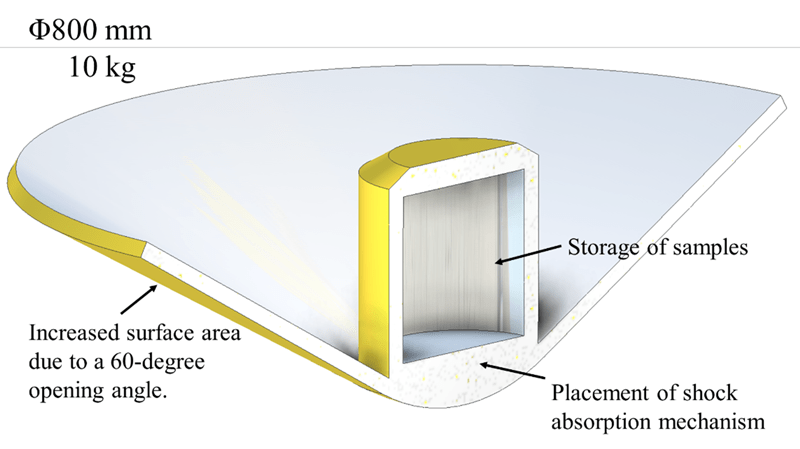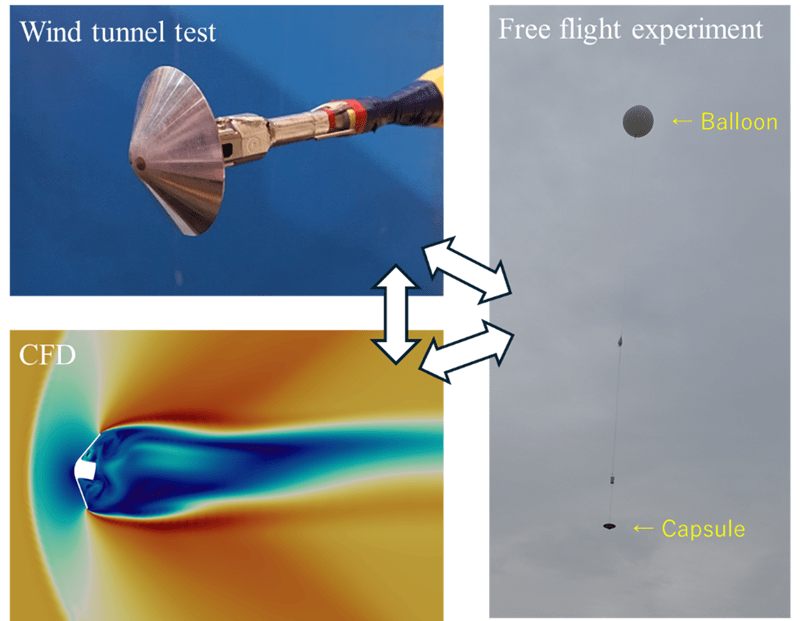Aerodynamic Instability in the Attitude of Sample Return Capsules During Earth Re-Entry from Deep Space
Jan. 22, 2025 | Aerospace Project Research Associate, ISAS people
Research Summary
This study investigates the aerodynamic behavior of sample return capsules during re-entry to Earth. The re-entry phase is the final stage of sample return missions, such as the Hayabusa mission, which returned extraterrestrial material to Earth. During re-entry, the sample-containing capsule separates from its spacecraft and experiences free fall toward Earth. In conventional designs, a parachute deploys just before landing to ensure a safe touchdown.

The project to which I belong is developing a next-generation sample return capsule for missions returning from deep space beyond the snow line. Assuming a sample return from the Saturn’s gravitational sphere, the velocity of these capsules can reach up to 15 km/s during re-entry, significantly higher than the 12 km/s achieved by the Hayabusa capsule. This increased velocity introduces more severe aerodynamic heating*1, exceeding the capabilities of conventional thermal protection systems. To address this problem, a novel capsule design has been proposed. By increasing the capsule's size and reducing its weight, it achieves deceleration at higher altitudes, where the atmospheric density is lower, effectively mitigating aerodynamic heating. As shown in Figure 1, the thin aeroshell capsule eliminates the need for a parachute and relies entirely on aerodynamic drag for deceleration.
My research focuses on refining the capsule's design to enhance aerodynamic stability, minimize oscillations, and ensure proper attitude at landing, all without the use of active control mechanisms. Previous studies on Hayabusa-type capsules revealed increasing oscillations during free flight, which were attributed to aerodynamic instability*2. While these capsules have successfully completed their missions, the mechanisms of this instability remain inadequately understood.
Therefore, to elucidate the mechanism, we conduct wind tunnel tests, numerical simulations, and free-flight experiments, as illustrated in Figure 2. In the wind tunnel test, the capsule is mounted on a support rod, constraining its motion. While this setup limits the observation of complete free-flight dynamics, it allows for multiple trials, controlled experiments to evaluate aerodynamic responses. By analyzing single or triple-axis oscillations, we aim to uncover the interplay between aerodynamic forces and motion, advancing our understanding of this phenomenon and paving the way for improved capsule designs.

Numerical analysis provides simulation for free rotational motion of the capsule without the constraints imposed by support rods in wind tunnel experiments. However, such simulations take high computational costs, often requiring weeks to simulate only a few seconds of physical time with sufficient resolution. Consequently, numerical analysis is applied selectively to specific conditions identified from wind tunnel experiments, offering detailed insights into flow fields, including pressure, density, and temperature distributions, to uncover the mechanisms.
To simulate re-entry conditions, free-flight experiments are conducted by releasing the capsule from altitudes of tens of kilometers using balloons or rockets. These tests are significantly harder, often requiring years of preparation. As a result, the number of test cases is limited compared to wind tunnel experiments. Conditions for these experiments are carefully selected based on prior results to maximize the likelihood of obtaining impactful findings. Free-flight testing is not the end point of the research. Results from flight tests are used to inform subsequent wind tunnel experiments and numerical simulations, refining the understanding of aerodynamic behavior and validating observed phenomena.
This research utilizes facilities such as wind tunnels and balloon flight platforms provided by JAXA and ISAS. While professors at university can use these, the expertise for experiments at ISAS has been invaluable. Collaborating with experienced researchers and instructors who share insights gained from direct involvement in wind tunnel and balloon experiments has significantly enhanced the quality and efficiency of our research. These insights gained from actual items highlight the unique advantages of conducting research at ISAS.
Terminologies
- *1 Aerodynamic heating : At the leading edge of a high-speed object in flight, the gas stagnates. Specifically, in the hypersonic regime (Mach 5 and above), rapid compression occurs, leading to adiabatic heating as kinetic energy is converted into thermal energy. This process causes a significant increase in the gas temperature at the object's leading edge.
- *2 Aerodynamic instability : The phenomenon where an oscillation of capsule diverges due to aerodynamic forces during free flight. It is particularly observed in the subsonic and transonic regimes.


 TAKASAWA Hideto / Dept. of Space Flight Systems, ISAS
TAKASAWA Hideto / Dept. of Space Flight Systems, ISAS